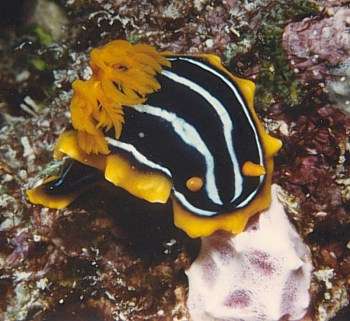
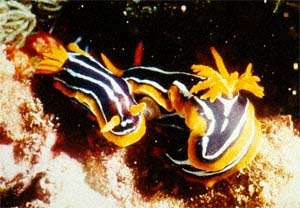
Chromodoris kuiteri
Rudman, 1982
Order: NUDIBRANCHIA
Suborder: DORIDINA
Family: Chromodorididae
DISTRIBUTION
Known only from northern New South Wales, Queensland and possibly northwestern Western Australia.
PHOTO
UPPER: Heron Island, Great Barrier Reef, Queensland, December 1980. PHOTO: Geoff Avern.
LOWER: Mooloolaba, Sunshine Coast, southern Queensland. PHOTO: Steve Grail.
The predominant colour on the mantle is black with a broad orange border. The boundary between the orange border and the black is diffuse. There are four thin white longitudinal lines in the black region. The outer on each side runs parallel to the border joining anteriorly in front of the rhinophores and posteriorly behind the gills. The inner pair of lines run forward between the rhinophores, in some specimens joining to form an anterior loop. Posteriorly the lines run back, one on each side of the gill pocket to meet in the posterior midline. A short median line runs back from this junction.
The rhinophore and gill pockets are bordered with orange and the gills and rhinophores are uniformly orange, usually of a more intense colour than the border. The sides of the body and the foot are black with three white lines. Sometimes a line may be absent or secondary lines present. The foot is bordered with a broad orange band.
The body is elongately ovate. The gills are simple with a tendency towards secondary branching in larger specimens. The gills are arranged in a horseshoe, open posteriorly, and at the posterior ends they recurve to form an inner spiral on each side of the anal papilla. The number of gills varies with the size of the animal, the maximum so far counted is 16.
Reference:
• Rudman, W.B. (1982) The Chromodorididae (Opisthobranchia: Mollusca) of the Indo-West Pacific: Chromodoris quadricolor, C. lineolata and Hypselodoris nigrolineata colour groups. Zoological Journal of the Linnean Society 76: 183-241.
Rudman, W.B., 2003 (November 12) Chromodoris kuiteri Rudman, 1982. [In] Sea Slug Forum. Australian Museum, Sydney. Available from http://www.seaslugforum.net/find/chrkuit
Related messages
Re: 'Pyjama slugs' from the Red Sea
October 19, 2005
From: Kamal El Tawil
Dear Bill:
The gills on Matan's Chromodoris are green [message #14975]. The ones on the animal of message #9457 are a typical orange. Can you please comment ?
Regards.
Kamal:
ktawil@yahoo.com
El Tawil, K., 2005 (Oct 19) Re: 'Pyjama slugs' from the Red Sea. [Message in] Sea Slug Forum. Australian Museum, Sydney. Available from http://www.seaslugforum.net/find/15042Dear Kamal,
I am pretty sure the greenish colour is not 'real'. It's either something to do with the depth the animal was photographed at or more likely something to do with the 3 colour RGB format we use to display images. A slight imbalance in either the Cyan-Red or Magenta-Green scales can lead to a greenish tinge like this. I sometimes do a global rebalance of colours in images which are clearly in need of help, but usually don't interfere with images in case I get it wrong.
Best wishes,
Bill Rudman
Re: 'Pyjama slugs' from the Red Sea
October 10, 2005
From: Matan Ninio
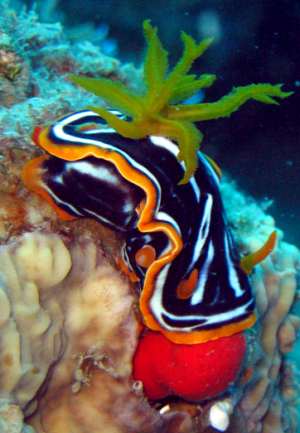
Dear Bill,
Here is another example of this "Chromodoris africana " color form, again from Eilat. This time it's got it's head deep in a red sponge.
Locality: Shirat Hayam Kenion, Dekel beach, Eilat. Israel. Red Sea. Depth: 23 m. Length: 50 mm. 9 October 2005. Photographer: Oded Bar-Lev
Matan Ninio
matan@forumhasofiot.yam.dive.ninio.org
Ninio, M, 2005 (Oct 10) Re: 'Pyjama slugs' from the Red Sea. [Message in] Sea Slug Forum. Australian Museum, Sydney. Available from http://www.seaslugforum.net/find/14975Dear Matan,
This is a nice find. Although I am not a great believer in common names, 'Pyjama slugs' is certainly a nice way of labelling this colour group. This animal is almost certainly the same as the lower left photo in Ilan Ben Tov's earlier message [#9457] from the Red Sea. If colour patterns mean anything then I think I have to identify this asChromodoris kuiteri . Certainly Ilan's animal looked identical to eastern Australian specimens, and although the white lines in your animal are a bit irregular, it is the only species of this colour group in which there is black pigmentation on the inside edge of the orange mantle border.
Finding it on this red sponge is also exciting because it is almost certainly the same red sponge that C. quadricolor is usually found on. I have a record on the Forum [#1404] of this species feeding on Dysidea, but this could be wrong as it was based solely on the a photo that accompanied the specimen.
I could of course be quite wrong in thinking this is C. kuiteri, and this may be a strange colour form of C. quadricolor, but I suspect the best way to find out is for local observers like you, to keep an eye on these 'Pyjama slugs' and see if you can find some biological differences. It would be wonderful if you could find different colour 'forms' laying eggs - either the same or different, or mating etc etc. Perhaps you can notice a different shape of the body. For instance, in C. quadricolor and C hamiltoni, the mantle skirt down each side of the body is quite narrow compared to the relatively wide and thin skirt of C. africana. What we have here is almost certainly a case of mimicry, much like the red-spotted species I describe from southeastern Australia. This mimicry has evolved to survive predation, but although out brains are better than fishes, it is sometimes difficult, even for us, to separate one species from another on external colour patterns.
Best wishes,
Bill Rudman
Could this be Chromodoris africana?
November 13, 2003
From: Gary Cobb
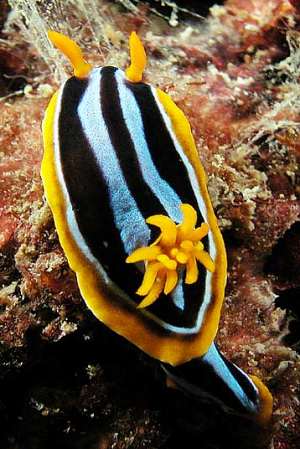
Hi Bill!
Please find attached a photo I took while on a night dive here at Wait-a-while off Mooloolaba, Queensland, Australia, 19 degree water, 14m depth, length about 70mm. "It" was quite large and beautiful! Could this be Chromodoris africana?
Thanks
Gary Cobb
gary@cobb.com.au
Cobb, G., 2003 (Nov 13) Could this be Chromodoris africana?. [Message in] Sea Slug Forum. Australian Museum, Sydney. Available from http://www.seaslugforum.net/find/11348Dear Gary,
As far as we know C. africana is a western Indian Ocean species althought ther are some puzzling animals from the Pacific which I am calling Chromodoris cf. africana at present for want of a better idea. Your animal however is Chromodoris kuiteri. The black pigmentation on the inside edge of the orange mantle border is a good character for this species
Best wishes
Bill Rudman
Chromodoris kuiteri laying its spawn
April 11, 2003
From: Julie Marshall
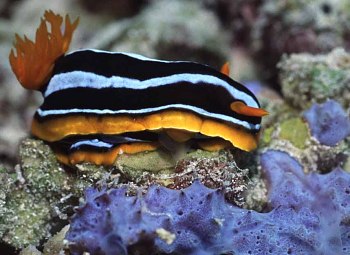
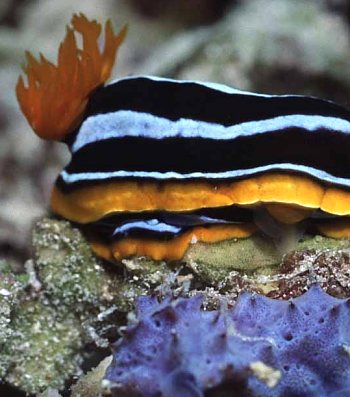
Dear Bill,
Attached is a picture of a Chromodoris kuiteri laying its spawn. It was taken at Heron Island [Great Barrier Reef, Queensland] on 28th March 2003 at a depth of 14m. The animal was 45mm in size.
Best wishes,
Julie Marshall
juliemarshall@netspace.net.au
Marshall, J., 2003 (Apr 11) Chromodoris kuiteri laying its spawn. [Message in] Sea Slug Forum. Australian Museum, Sydney. Available from http://www.seaslugforum.net/find/9635Thanks Julie,
It's nice to have a photos of another of these species which lay a flat egg coil. I have also included the blue sponge in the closeup as I wouldn't mind keeping an eye out for C. kuiteri eating this sponge.
Best wishes,
Bill Rudman
Chromodoris kuiteri from Lord Howe Island
January 25, 2003
From: W.B. Rudman
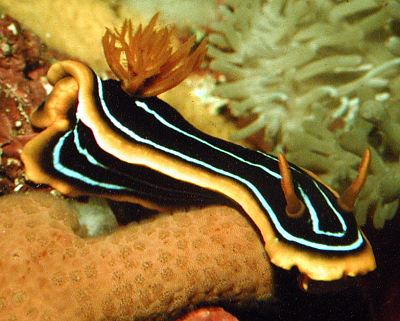
Here is a photo record from Ian Hutton of Chromodoris kuiteri from Lord Howe Island.
Location: South Reef.
Bill Rudman
Rudman, W.B., 2003 (Jan 25) Chromodoris kuiteri from Lord Howe Island. [Message in] Sea Slug Forum. Australian Museum, Sydney. Available from http://www.seaslugforum.net/find/8947Chromodoris kuiteri from nthn New South Wales
June 12, 2000
From: A. Lumnitzer
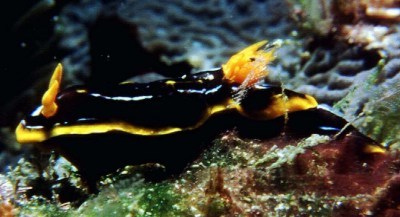
Dear Bill,
Is this Chromodoris kuiteri? It is also from North Solitary Ids, off Coffs Harbour, norhtern New South Wales, September 1998 in 12 meters of water.
Akos
akos72@hotmail.com
Lumnitzer, A., 2000 (Jun 12) Chromodoris kuiteri from nthn New South Wales. [Message in] Sea Slug Forum. Australian Museum, Sydney. Available from http://www.seaslugforum.net/find/2552Dear Akos,
Yes this is a dark specimen of C. kuiteri.
Best wishes,
Bill Rudman.
Food of Chromodoris kuiteri
October 7, 1999
From: Bill Rudman

While cleaning up some files I found this interesting photo of Chromodoris kuiteri feeding on this sponge which I think is a species of Dysidea.
It was taken by Geoff Avern at Heron Island, Great Barrier Reef, Queensland, December 1980.
Bill Rudman.
Rudman, W.B., 1999 (Oct 7) Food of Chromodoris kuiteri. [Message in] Sea Slug Forum. Australian Museum, Sydney. Available from http://www.seaslugforum.net/find/1404Chromodoris kuiteri from Heron Island
June 27, 1999
From: Nerida Wilson

Dear Bill,
Is this Chromodoris kuiteri? it is from Tenements 1, Heron Island, Great Barrier Reef, Queensland.
Nerida.
nwilson@zoology.uq.edu.au
Wilson, N., 1999 (Jun 27) Chromodoris kuiteri from Heron Island. [Message in] Sea Slug Forum. Australian Museum, Sydney. Available from http://www.seaslugforum.net/find/967Dear Nerida,
Yes, it's C. kuiteri. Similar in general appearance to Chromodoris magnifica, but one major difference is that in C. magnifica the inside edge of the orange border is adjacent to a white region, while in C.kuiteri there is a black band alongside the inner edge of the orange border.
Best wishes,
Bill Rudman.
re: Food for Chromodoris kuiteri
December 7, 1998
From: Nerida Wilson
Dear Bill,
Thanks for your reply. I am after that information so I can do some lab work on C. kuiteri without it starving to death!
I am about to begin an honours project at the University of Queensland on Chromodorid reproduction. I am mainly looking at sperm morphology and spawn characteristics, but am hoping to record spawning behaviour as well.
My background is from temperate waters; I did my undergrad at University of Melbourne, so my local knowledge is zero!! Please help!! If anyone has local species lists and/or any reproductive info (photos of spawning and egg masses) please don't be shy!!
Nerida Wilson
7 Faversham St
Woolloongabba
Queensland 4102
Australia
neridagwilson@excite.com
Wilson, N., 1998 (Dec 7) re: Food for Chromodoris kuiteri. [Message in] Sea Slug Forum. Australian Museum, Sydney. Available from http://www.seaslugforum.net/find/365Thanks for the information Nerida. I've put a copy on the Participant's Page. I suggest you get in touch with Wayne Ellis (glaskin@ozemail.com.au ), whose contact detail are on the Participant's Page. As I have said many times before if anyone has interesting photos of eggs, spawning, feeding etc, it would help us all if I could borrow and scan them so we could all have a look. ... Bill Rudman.
Food for Chromodoris kuiteri
November 27, 1998
From: Nerida Wilson
I was wondering if anyone has any information on what Chromodoris kuiteri eats, particularly in the area of Cook Island, northern New South Wales?
Nerida Wilson
neridagwilson@excite.com
Wilson, N., 1998 (Nov 27) Food for Chromodoris kuiteri. [Message in] Sea Slug Forum. Australian Museum, Sydney. Available from http://www.seaslugforum.net/find/333Dear Nerida,
I have records of it feeding on an unidentified species of the sponge Dysidea in southern Queensland and I assume it probably feeds on the same in northern New Spouth Wales. If you could let me know why you want to know it would be easier to help. Are you looking for the slug? or have you found it feeding on something and want to identify the food?
If you have found it commonly on a sponge I would very much like a photograph of it and the sponge, and a sample of the sponge. two days ago I was talking to Dr Pat Bergquist, a leading world expert on sponges who is at the moment wrapping up a revision of the genus in the tropics. If I can get some material for her it will possibly help her revision and help us identify another food sponge of a nudibranch.
Another person worth contacting would be Wayne Ellis (see his message below).
Reference: Rudman, W.B. (1984d) The Chromodorididae (Opisthobranchia: Mollusca) of the Indo-West Pacific: a review of the genera. Zoological Journal of the Linnean Society 81: 115-273.
Best wishes,
Bill Rudman
A Chromodoris from Mooloolaba
June 22, 1998
From: Wayne Ellis
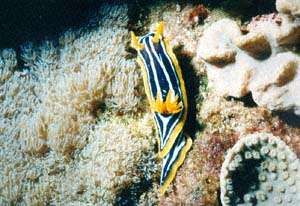
Hi Bill,
Here is another of Steve Grail's photos. It was taken off Mooloolaba, Sunshine Coast, southern Queensland, in 10-20m, between 1996 and 1998.
Regards
Wayne Ellis
glaskin@ozemail.com.au
Ellis, W., 1998 (Jun 22) A Chromodoris from Mooloolaba. [Message in] Sea Slug Forum. Australian Museum, Sydney. Available from http://www.seaslugforum.net/find/44They are Chromodoris kuiteri. In a number of the chromodorids with this basic colour pattern, including Chromodoris westraliensis, Chromodoris elizabethina, Chromodoris magnifica the orange of the mantle border, gills and rhinophores seems to vary in different individuals from yellow to a deep orange. Since I first described this species nearly 20 years ago I know of no further records from Western Australia other than the single one from Houtman Abrolhos Ids that I recorded then. Since it is not uncommon in northern New South Wales and southern Queensland, it is possible that the Western Australian record is a mistake. Any sightings from outside northern NSW and southern Queensland would be valuable in determining its distribution.. Bill Rudman
Rudman, W.B., 1998 (Jun 22). Comment on A Chromodoris from Mooloolaba by Wayne Ellis. [Message in] Sea Slug Forum. Australian Museum, Sydney. Available from http://www.seaslugforum.net/find/44